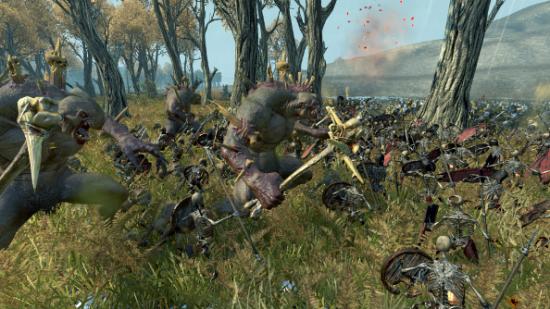I’m watching a group of hungry, dragon-sized vampire bats tear chunks out of some Dwarfs with guns outside of an absurdly gothic castle filled with skeletons, zombies, and a couple of banshees. It’s a small part of a fantastical battle of gargantuan proportions. For a moment, I sit there and appreciate the fact that I’m witnessing and controlling this fight in a Total War game without the benefit of a single mod.
Want more tiles and war-waging? Check out the best strategy games on PC.
Unshackled from history and reality, Total War: Warhammer is as much a re-imagining of Creative Assembly’s 16-year-old series as it is a spin-off or a sequel. The epic big-picture campaign, the tactical real-time battles, the language, and the UI might all be fundamentally familiar, but none of them have escaped revision or augmentation. It’s refreshing, certainly, and often bold, but not everything that’s new is an unmitigated success.
A Total War campaign begins with an agonising decision: who the hell am I going to lead to victory and glory first? It normally takes an age for me to decide, as I pour over the multitude of faction summaries. In Warhammer, there are only four: the Empire, Vampire Counts, Dwarfs, and Greenskins. Five if you also get the Chaos Warriors DLC. It should be easier, then, to pick a faction, but it isn’t remotely.
See, the four main factions of Warhammer are more diverse than any that Creative Assembly have created before. Units, buildings, tech trees and a couple of unique systems ensure that no two feel alike, and this isn’t a case of reskinning things to suit a faction’s aesthetic; these are meaningful differences.
Take the burly Dwarfs, for example. They have no cavalry or magic, but have explosives, guns and deadly artillery, along with various gyrocopters. They’re also blessed with a huge tech tree and a strong economy. Their unique system is the Book of Grudges, which transforms every slight against the Dwarfs – attacks, raids, assassination attempts – into a quest for revenge, and the more grudges that accumulate, the less faith the Dwarven leadership has in its king, resulting in instability.
Starting positions – geographically speaking – make a big difference in terms of diversity, too. The Dwarfs start off in the mountains, and their territory is mostly narrow, winding valleys and paths through huge mountain ranges. It makes navigating Dwarfen kingdoms a nightmare, unless you’re playing as the Dwarfs or Orcs, who can travel through ancient underground paths.
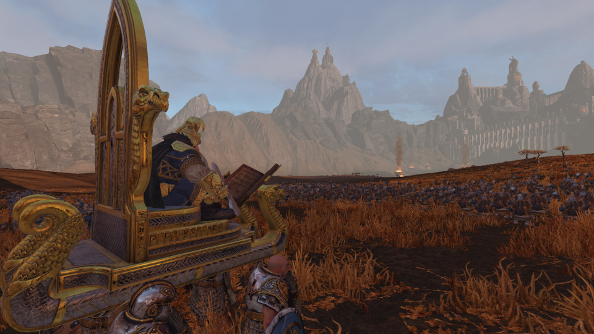
This all leads to Warhammer offering up some of the most interesting, asymmetrical wars and battles in the Total War series. And the limitations, like the lack of Dwarfen cavalry or the admittedly inexplicable dearth of undead ranged units, merely add to the tactical conundrums that make a battle compelling. It’s worth noting, as well, that this asymmetry doesn’t necessarily lead to imbalance.
Warhammer’s undead aristocrats, the Vampire Counts, might not have ranged units, for instance, but they have several flying ones – they get their first straight away – which extend the range of their attacks. They don’t rout, either, which is simultaneously brilliant, because you’ll never lose control of them, and terrifying, because units are more likely to be wiped out.
Like the factions, the roster of recruitable units is quite small, but infinitely more memorable than the many different-but-not-really dudes with swords and spears from the previous games. Ghouls, giants, dragons, holy engines of war, knights flitting around on pegasi – these are troops you’re not going to forget. It’s not just a matter of cosmetics, either, or even stats. A giant isn’t simply bigger and stronger than an ordinary warrior, it can fling men around and stomp on them. Its size and strength have a tangible impact on the fight.
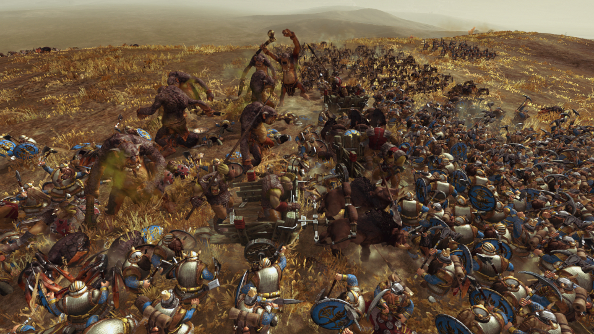
The cosmetic stuff is still important, though. It makes battles easier to read when units are this simple to identify – you’re not going to have a hard time spotting a building-sized spider. And, let’s not beat around the bush here, it looks incredible. Total War: Warhammer is a stunning game, from the campaign map full of fantasy flourishes like skull rocks and the growth of vampiric and chaos corruption, to the battles in great underground caverns or beneath the gaze of imposing mountain fortresses.
Warhammer’s real-time battles are still built on the easy-to-learn foundations of Total War combat. For all their special passive abilities, bonuses and stats, units still broadly follow the rock, paper, scissors model, while more nuance is added by elevation and forests, which affect the field of view and give units certain advantages. If you’ve played a Total War game before, you’ll know what you’re doing, but there are a few extra things now waiting to be learned.
How best to use magic is one of them. Lords and heroes (generals and agents) can cast spells during a fight that are unlocked when they level up. How many spells they can cast in a given battle depends on the Winds of Magic, which constantly shift. Most of them are, disappointingly, buffs and debuffs that use the same spell effects, and are perhaps not as flashy as one might hope. There are a lot more spells that heal and bolster units than giant vortexes of doom, and though they might be handy, they are a wee bit dull.
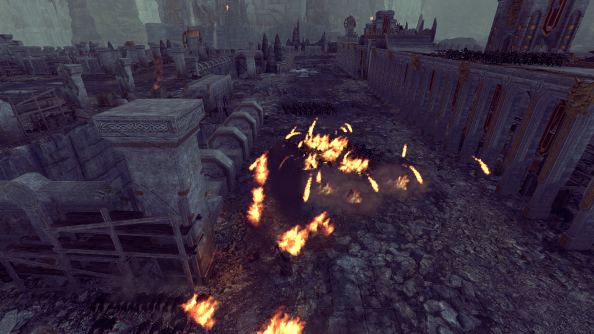
However! They do make lords and heroes substantially more important than their historical counterparts. Not only can they turn the tide of a battle with a well-timed spell, they’re handy in a brawl, too. And their power can be increased by loot rewarded after a fight or a quest, so they are always growing and always earning their keep. Eventually, they get access to flying mounts so they can tear across the skies, avoiding and getting into scraps at their leisure.
When Total War: Warhammer lives up to its name, and everyone is fighting, and borders and constantly fluctuating, and there’s no room to breathe for all the conflict, this is one of the high points of the entire series. Unfortunately, war more often comes in spurts, and with breathing room comes the realisation that the game continues to struggle with things that have plagued Total War for years, and that a lot of its new additions aren’t nearly as well realised as the faction diversity or thrilling, fantastical battles.
Campaign AI and diplomacy have become the twin banes of my existence. They’ve never been the series’ strongest feature, but in Warhammer it feels like another step back has been taken. In my first campaign, playing as the Dwarfs, I actually had to swear off diplomacy for a big chunk of the game because it was too easy to exploit. I found myself in a cycle where money and deals were being flung at me, neutering any challenge or need for empire management.
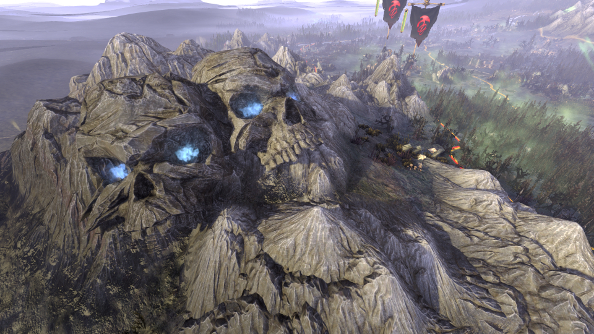
The Dwarfs begin, like all the other factions, as merely one group within a race. So the playable Dwarfs are not the only stumpy mountain-dwelling folk. My Dwarfen cousins really liked me and my faction of go-getting hirsute blokes, so they were constantly sending me trade deals and offers of friendship. That’s fine – I like making friends. It wasn’t an even friendship, though.
“Come join us in a war against these guys,” they’d ask, with great frequency. “We’ll give you lots of gold.” How could I refuse? So I’d take their cash and join their war, and then I do… absolutely nothing. I had my own wars and worries. And then I’d get the inevitable message from, let’s say the Vampire Counts, asking me to leave the war. And yes, they’d offer me money too. So I’d take it. A few turns later… “Come join us in the war against these guys. These same guys. Here’s some cash again, too.”
This went on and on, and nobody seemed to care that I was constantly leaving wars or that I wasn’t actually participating in them. I was rich, and I didn’t have to do anything.
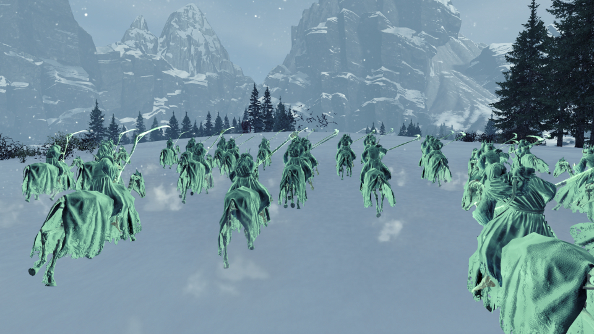
It should be noted at this point that CA themselves advocate that experienced Total War players should jump in at one of the harder difficulty levels. On Very Hard, for instance, they say that “The game will be unforgiving and you’ll need to find ways to get the most out of all areas of the game, including battle, campaign economy, diplomacy and character skills. Nasty inescapable situations are likely to be encountered frequently by the ill-prepared and unwary, so you should exercise caution when planning your next expansion.”
However we have tested the game on a higher difficulty, and exploitable diplomacy and unsatisfying AI opponents aren’t just problems on Normal, which is where most players will end up. Cranking it up a tier does make the game more challenging, certainly, especially in the already engaging and reasonably tricky real-time battles, but these flaws in the campaign persist regardless of the challenge setting.
Along with the easily exploitable diplomacy, the campaign struggles due to its lack of tension. Most of the map is taken up by the aforementioned minor, unplayable factions, but they are often excessively timid, and serve mostly to be gobbled up by the main faction of their race. They can be allies or opponents, but they’re always just more fuel for the war machine.
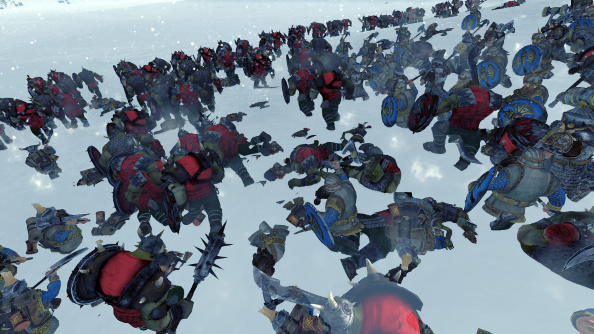
There’s a narrative reason for this. Total War: Warhammer is all about uniting the diaspora to put up a stronger defence against the inevitable wave of Chaos that’s building in the north. So the point is to invite these minor factions into a confederation – they seem predisposed to this, even if you keep leaving their wars – or simply by conquering them, which isn’t much of a challenge thanks to their aforementioned timid natures.
One thing that’s missing – and their absence is really noticeable – are established empires. There are no Roman Empires or Sassanids, no lumbering behemoths that present a deadly and immediate threat but that can cautiously be taken apart. Every faction begins as small and meek, so the first order of business is always expansion. Despite the faction variety, they all start out in a similar situation, with a similar goal: become more powerful. And that’s actually pretty easy.
Through quests and easy pickings, Warhammer gives you everything you need to become a burgeoning superpower before you even have your first clash with one of the other main factions. By that point, things admittedly pick up considerably, as that promised Total War begins. And when the Chaos Warriors march south, that’s when the game really starts. It’s just a shame that you might not even spot a Chaos legion before you hit 100 turns.
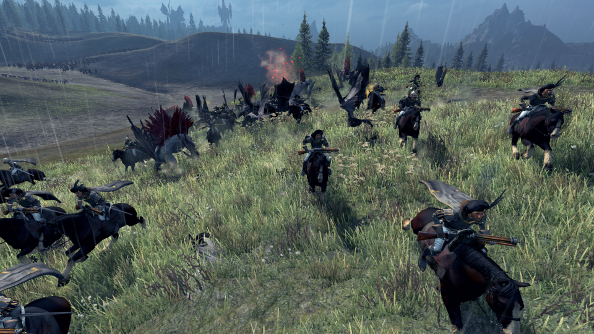
The Chaos Warriors call to mind the Huns from Attila. They are the game’s major threat, and like the Huns they pour out of their lands, raiding and burning everything they see. And where they go, they spread chaotic corruption, destabilising regions and inciting revolt. They are a real menace. Unlike the Huns, however, they are a blunt instrument, and a fleeting threat.
In Attila, the rise of the Huns heralds a dramatic change in the campaign. Factions find themselves homeless, forced to move south and west into other lands, causing problems in the regions they move to. The whole world starts to shift. And the Huns, though their push west makes them seem like a force of nature, are still able to make deals and temporary alliances.
The Chaos Warriors, on the other hand, are just destroyers. They move south and raze every settlement to the ground. That’s it. They exist in a state of constant war with the other factions, so they never do more than fight. And their war against the world means that they lack focus, continually being pulled between different conflicts, whittled down by players and AI alike. So for a while, they might seem like this terrifying threat, and in every game I’ve played they’ve annihilated vast swathes of the world, but eventually they die from a thousand cuts. It’s a bit of an anti-climax.
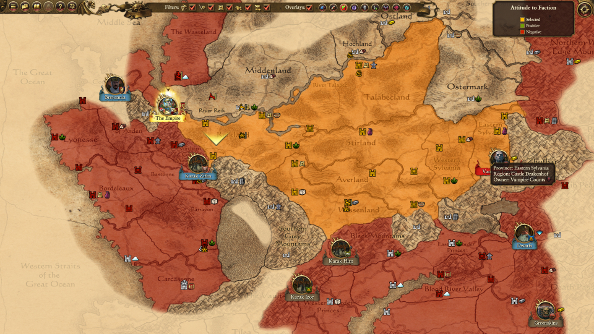
Like quite a lot of Warhammer, the threat of Chaos is a great idea that stops shy of being great in practice. The role-playing elements are another. Warhammer has loot and quests and heroic abilities in spades, but lacks one key thing: actual characters, the one ingredient that keeps the others connected. Sure, your lords and heroes have names and a backstory, but they don’t have personalities, motivations or ambitions. The quests they go on are impersonal things, missions to go and fight in a battle half-way across the world for a new sword, that only serve to get them get bigger numbers in their character sheet.
Look, this is a strategy game, not an RPG, so I’m not expecting The Witcher 3’s character development, but I already know Creative Assembly can do more, because they’ve done it before.
Not for the first time in this review, I’m suggesting that Total War: Warhammer should be more like Attila, which I realise is strange given that one of the game’s strengths is that it is so different from its predecessors. But Attila’s court intrigue was a fantastic addition, breathing life into generals and leaders, giving them families, desires and influence, along with all the wrinkles they add to the running of an empire. Warhammer desperately needs that extra layer of dynamism.
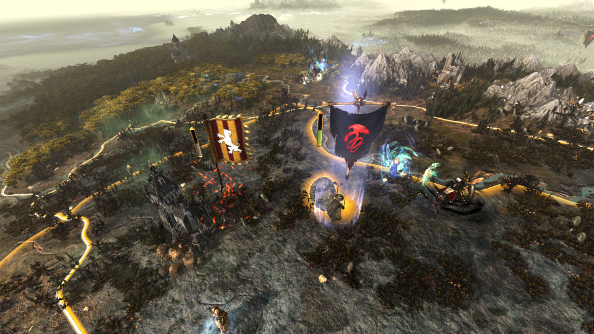
This is not to say that Creative Assembly’s attempts to mix some RPG mainstays into the game isn’t welcome. Despite my complaints, quests encourage conflict and exploration, spicing up the sometimes dull early game, while gear offers up a second path to increasing the power of your all-important lords of heroes. That the objects are all drawn from the lore of the tabletop game is an added bonus.
Special, curated battles are the real quest rewards, anyway. Who cares about a sword with +3 melee damage when you’ve got a titanic clash waiting for you in an exotic location? These fights are the best of the bunch, tailored and sometimes containing a trick or two, perhaps a special objective. Conveniently you don’t need to actually get the quest to experience them, as they also take the place of historical battles, and thus can be played immediately by selecting them from a menu. That’s also where you’ll find custom battles and multiplayer brawls.
I’ve found myself drawn toward those one-off multiplayer and skirmish battles more than in any previous game. The new additions to the real-time scraps – the fancy units, special rules for each race, the occasional magical surprise – make me want to rush through the campaign faffing to get to them, so leaping into them straight away is a very attractive prospect.
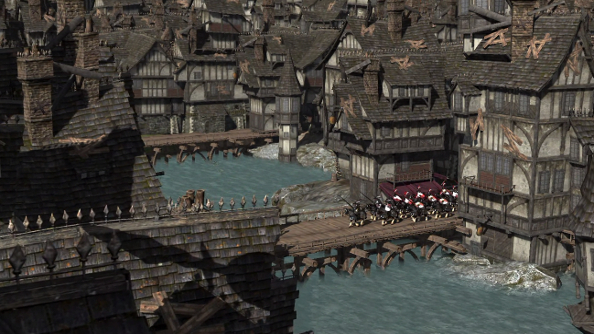
Total War: Warhammer has made me re-evaluate what I really wanted from Creative Assembly’s foray into the fantastical. I thought I wanted a clean sheet, everything new and surprising, but now I find myself missing old features that didn’t make the cut. And out of all the things that stuck around, why oh why was that awful diplomacy system one of them? I wouldn’t want to sacrifice any of the new things to get them back, though.
The quests and loot, the magic, the giant and flying units, that one Chaos lord whose surname is “Deathmetal”; these are all things I wouldn’t want to lose. Even the parts that need time to mature or require a bit more follow through, I’m glad that they made it in. Many paragraphs ago, I said that not everything new is an unmitigated success, but the overall experiment, the transposition of Total War to an entirely new universe, is. It does feel like phase one, however, with its focused scenario of uniting your race against Chaos, leaving a lot of space to grow, and I find myself more intrigued with what it might become.
Total War games past have expanded, changed and morphed over time and this will doubtless be similar. As it stands, Warhammer is a worthy addition to the series, particularly as a melding of two universes we’ve long wanted to see collide. And before long, as the patches roll in, it could be even more than that.
7/10
Got some thoughts of your own on Creative Assembly’s latest effort? Let us know in the comments below.
